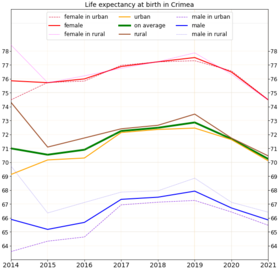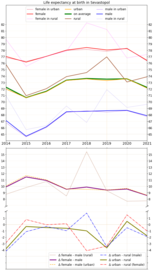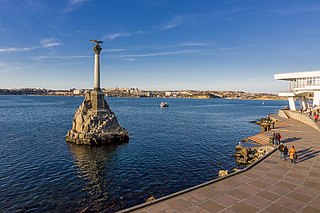
Sevastopol, sometimes written Sebastopol, is the largest city in Crimea and a major port on the Black Sea. Due to its strategic location and the navigability of the city's harbours, Sevastopol has been an important port and naval base throughout its history. Since the city's founding in 1783 it has been a major base for Russia's Black Sea Fleet, and it was previously a closed city during the Cold War. The total administrative area is 864 square kilometres (334 sq mi) and includes a significant amount of rural land. The urban population, largely concentrated around Sevastopol Bay, is 479,394, and the total population is 547,820.

Crimea is a peninsula in Eastern Europe, on the northern coast of the Black Sea, almost entirely surrounded by the Black Sea and the smaller Sea of Azov. The Isthmus of Perekop connects the peninsula to Kherson Oblast in mainland Ukraine. To the east, the Crimean Bridge, constructed in 2018, spans the Strait of Kerch, linking the peninsula with Krasnodar Krai in Russia. The Arabat Spit, located to the northeast, is a narrow strip of land that separates the Syvash lagoons from the Sea of Azov. Across the Black Sea to the west lies Romania and to the south is Turkey. The largest city is Sevastopol. The region has a population of 2.4 million, and has been under Russian occupation since 2014.
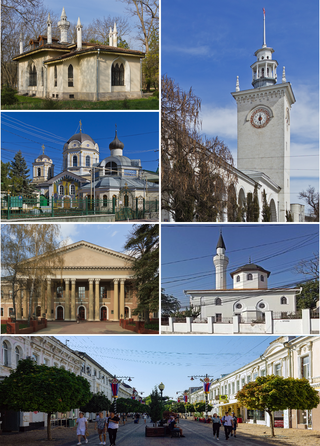
Simferopol, also known as Aqmescit, is the second-largest city on the Crimean Peninsula. The city, along with the rest of Crimea, is internationally recognised as part of Ukraine, and is considered the capital of the Autonomous Republic of Crimea, but currently is under the de facto control of Russia, which annexed Crimea in 2014 and regards Simferopol as the capital of the Republic of Crimea. Simferopol is an important political, economic and transport hub of the peninsula, and serves as the administrative centre of both Simferopol Municipality and the surrounding Simferopol District. Its population was 332,317 .

Crimean Tatars or Crimeans are a Turkic ethnic group and nation native to Crimea. The formation and ethnogenesis of Crimean Tatars occurred during the 13th–17th centuries, uniting Cumans, who appeared in Crimea in the 10th century, with other peoples who had inhabited Crimea since ancient times and gradually underwent Tatarization, including Greeks, Italians, Goths, Sarmatians, English and others.

Bakhchysarai is a town in the Autonomous Republic of Crimea, Ukraine. It is the administrative center of the Bakhchysarai Raion (district), as well as the former capital of the Crimean Khanate. Its main landmark is Hansaray, the only extant palace of the Crimean Khans, currently open to tourists as a museum. Population: 27,448 .

Yevpatoria is a Ukrainian city of regional significance in Western Crimea, north of Kalamita Bay. Yevpatoria serves as the administrative center of Yevpatoria Municipality, one of the districts (raions) into which Crimea is divided. It had a population of 105,719 .

Taurida Governorate was an administrative-territorial unit (guberniya) of the Russian Empire. It included the territory of the Crimean Peninsula and the mainland between the lower Dnieper River with the coasts of the Black Sea and Sea of Azov. It formed after Taurida Oblast was abolished in 1802 during the course of Paul I's administrative reform of the territories of the former Crimean Khanate which were annexed by Russia in 1783. The governorate's centre was the city of Simferopol. The name of the province was derived from Taurida, a historical name for Crimea.

The recorded history of the Crimean Peninsula, historically known as Tauris, Taurica, and the Tauric Chersonese, begins around the 5th century BCE when several Greek colonies were established along its coast, the most important of which was Chersonesos near modern day Sevastopol, with Scythians and Tauri in the hinterland to the north. The southern coast gradually consolidated into the Bosporan Kingdom which was annexed by Pontus and then became a client kingdom of Rome. The south coast remained Greek in culture for almost two thousand years including under Roman successor states, the Byzantine Empire (341–1204), the Empire of Trebizond (1204–1461), and the independent Principality of Theodoro. In the 13th century, some Crimean port cities were controlled by the Venetians and by the Genovese, but the interior was much less stable, enduring a long series of conquests and invasions. In the medieval period, it was partially conquered by Kievan Rus' whose prince Vladimir the Great was baptised at Sevastopol, which marked the beginning of the Christianization of Kievan Rus'. During the Mongol invasion of Europe, the north and centre of Crimea fell to the Mongol Golden Horde, and in the 1440s the Crimean Khanate formed out of the collapse of the horde but quite rapidly itself became subject to the Ottoman Empire, which also conquered the coastal areas which had kept independent of the Khanate. A major source of prosperity in these times was frequent raids into Russia for slaves.
Gaspra, officially transliterated Haspra, is a spa town, an urban-type settlement in Yalta Municipality in the Autonomous Republic of Crimea. It is located on the Black Sea coast, west of Yalta, and is a popular holiday resort. Population: 10,310 .

Foros is a resort town in Yalta Municipality of the Autonomous Republic of Crimea, a territory of Ukraine and occupied by Russia under the name of ″Republic of Crimea″. Population: 1,844 .

The Crimean Regional Government refers to two successive short-lived regimes in the Crimean Peninsula during 1918 and 1919.
Chornomorske or Chernomorskoye is an urban-type settlement and the administrative center of Chornomorske Raion in Crimea, a territory recognized by a majority of countries as part of Ukraine and occupied by Russia as the Republic of Crimea. It is located on the northern edge of the Tarkhankut Peninsula. Population: 11,267 ; 11,643.

Kirovske or Isliam-Terek is an urban-type settlement in the Crimea, a territory recognized by a majority of countries as part of Ukraine and incorporated by Russia as the Republic of Crimea. Population: 6,883 .

Krasnohvardiiske, also known as Krasnogvardeyskoye or Kurman, is an urban-type settlement in the Crimea, a territory recognized by a majority of countries as part of Ukraine and annexed by Russia. The town also serves as the administrative center of Krasnohvardiiske Raion (district) - also known as Kurman Raion - and houses the district's local administration buildings. Its population is 11,134 .

The Autonomous Republic of Crimea is an administrative division of Ukraine encompassing most of Crimea that was annexed by Russia in 2014. The Autonomous Republic of Crimea occupies most of the peninsula, while the City of Sevastopol occupies the rest.

The Republic of Crimea is a republic of Russia, comprising most of the Crimean Peninsula, but excluding Sevastopol. Its territory corresponds to the pre-2023 territory of Autonomous Republic of Crimea, a subdivision of Ukraine. Russia occupied and annexed the peninsula in 2014, although the annexation remains internationally unrecognized.
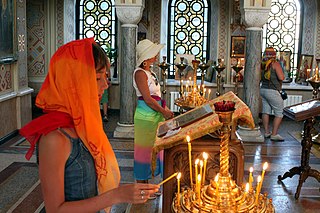
The majority of the Crimean population adheres to the Russian Orthodox Church, with the Crimean Tatars forming a Sunni Muslim minority, besides smaller Roman Catholic, Ukrainian Greek Catholic, Armenian Apostolic and Jewish minorities.

Berehove is an urban-type settlement in the Yalta Municipality of the Autonomous Republic of Crimea, a territory recognized by a majority of countries as part of Ukraine and annexed by Russia as the Republic of Crimea.
A variety of social, economical, cultural, ethnic, and linguistic factors contributed to the sparking of unrest in eastern and southern Ukraine in 2014, and the subsequent eruption of the Russo-Ukrainian War, in the aftermath of the early 2014 Revolution of Dignity.
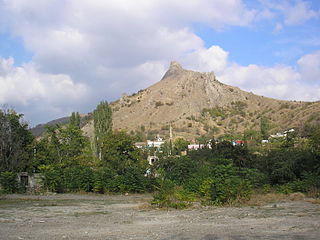
Mizhrichchia or Mezhdurechye is a village in the Feodosia Raion of Crimea, a territory recognized by a majority of countries as part of Ukraine and annexed by Russia as the Republic of Crimea.



